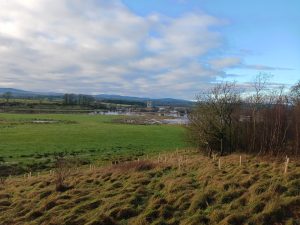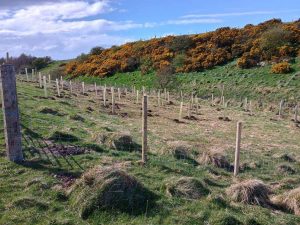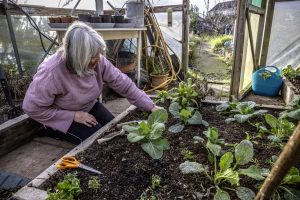World Environment Day – 5th June 2024

The World Environment Day campaign for 2024, led by the UN Environment Programme, focuses on land restoration, desertification and drought resilience. According to the UN Convention to Combat Desertification, up to 40 per cent of the planet’s land is degraded, directly affecting half of the world’s population. The Galloway and Southern Ayrshire Biosphere Partnership is proud to join the global community in championing the theme of land restoration and the benefits of nature when nurtured and restored.
The Importance of Land Restoration
Land restoration is a crucial step towards ensuring the health and resilience of our ecosystems and native species. Degraded and overused lands lead to a host of environmental problems, including loss of biodiversity, soil erosion, reduced agricultural productivity, and increased vulnerability to climate change. By restoring our natural landscapes, we can help reverse these adverse effects, enhance our ecosystems, and support a more sustainable way of living.
The GSA Biosphere Partnership believes that land restoration requires the collaboration of individuals, local communities, governments, and environmental organisations. Here in our UNESCO Biosphere, there are a variety of habitats and environments that we and some of the partner organisations working in the region are looking to help restore and protect for a greener, healthier future:
 Reforestation and Afforestation: Planting native tree species not only sequesters carbon but also restores habitats for wildlife. Our projects like the Ayrshire Small-Scale Tree Planting Grant (pictured right) have provided funding to help support the reintroduction of native species to woodlands and habitats, providing critical shelter and food sources for diverse species.
Reforestation and Afforestation: Planting native tree species not only sequesters carbon but also restores habitats for wildlife. Our projects like the Ayrshire Small-Scale Tree Planting Grant (pictured right) have provided funding to help support the reintroduction of native species to woodlands and habitats, providing critical shelter and food sources for diverse species.- Peatland Restoration: Peatlands are among the most effective carbon sinks on the planet. Unfortunately, many of our peatlands have been degraded by drainage and agricultural activities. Forestry and Land Scotland are undertaking restoration projects aiming to re-wet these areas, restoring their natural hydrology and enhancing their capacity to store carbon, within the Galloway and Southern Ayrshire Biosphere.
- Sustainable Agriculture: Promoting sustainable farming practices is essential for the long-term health of our land. By working with local farmers, land managers and community groups, the GSA Biosphere Partnership is keen to encourage techniques that improve soil health, reduce pesticides, and enhance biodiversity on agricultural lands.
- Community Involvement and Education: Successful land restoration depends on the active participation of local communities. Through educational programs and community-led initiatives, like our Biosphere Communities and Biosphere Footsteps programmes, we seek to help empower residents to take an active role in appreciating and restoring their natural environments.
Success Stories from our Biosphere
 One of the major landscape restoration projects in our Biosphere is the National Trust for Scotland Threave Landscape Restoration project (pictured left). This initiative has transformed a disused diary farm into a holistic habitat management project, with thriving ecosystems teeming with wildlife. The long-term project, with a 100-year vision for the site, views what was once a segregated landscape as a cohesive, open space in which natural heritage can flourish alongside a range of animals, insects and wildflowers. Threave is now a haven that features wildflower meadows, rich wetlands, and growing native woodlands that are buzzing with insect and bird life, including species rarely before seen in the Biosphere.
One of the major landscape restoration projects in our Biosphere is the National Trust for Scotland Threave Landscape Restoration project (pictured left). This initiative has transformed a disused diary farm into a holistic habitat management project, with thriving ecosystems teeming with wildlife. The long-term project, with a 100-year vision for the site, views what was once a segregated landscape as a cohesive, open space in which natural heritage can flourish alongside a range of animals, insects and wildflowers. Threave is now a haven that features wildflower meadows, rich wetlands, and growing native woodlands that are buzzing with insect and bird life, including species rarely before seen in the Biosphere.
Another landmark project is the restoration of the River Doon catchment. Over time, this area suffered from slurry spills, the effects of pollution and habitat loss, but the Ayrshire Rivers Trust have been working to help restore the Doon river and its tributaries to their former glory. Through collaborative efforts with farmers, involving riverbank stabilization, pollution control, and the creation of fish passages, the River Doon has seen a resurgence in its salmon population, a key indicator of a healthy river system. Recent work has included the Netherton Burn Restoration Project, one of the most important spawning locations for trout in the region.
How Can I Help?
As we celebrate World Environment Day 2024, the GSA Biosphere Partnership continues to support land restoration and nature-focused projects with our dedicated Land Use & Biodiversity team. However, the journey to a more sustainable natural environment requires effort, innovation, and cooperation from businesses, policymakers, activists and everyone in-between. Here are some steps you can take to help support this cause here in southwest Scotland:
- Support Restoration Projects: Whether it’s volunteering, donating, or advocating for policy changes, your support can make a significant impact on restoration efforts. From joining regenerative farming and growing groups to taking part in beach cleans-ups (such as those organised by MAC-CAN) to support our marine life, there’s plenty of ways to get involved and give back to nature.
 Adopt Sustainable Practices: From reducing waste and conserving water to supporting sustainable growers, every action counts towards a healthier planet. If you’re within their catchment zone, why not try buying some of your vegetables and produce from the Galloway Food Hub, which supports small-scale sustainable growers. If you have the space, you could always grow your own too.
Adopt Sustainable Practices: From reducing waste and conserving water to supporting sustainable growers, every action counts towards a healthier planet. If you’re within their catchment zone, why not try buying some of your vegetables and produce from the Galloway Food Hub, which supports small-scale sustainable growers. If you have the space, you could always grow your own too.- Educate and Raise Awareness: Educating the next generation of scientists, land managers, ecologists and change-makers on the benefits and importance of our habitats, species and land is crucial to supporting sustainable land management for generations to come. The Biosphere supports education in schools with the Learning For Sustainability and Blue Biosphere programmes.
- Engage with Nature: Sometimes the best way to understand the importance of our natural environment is by getting out and connecting with it. Take the time to visit and explore some of the natural areas in our UNESCO Biosphere, from nature reserves operated by the RSPB, Scottish Wildlife Trust and others, to local greenspaces. All habitats are important and help us foster a connection to nature.
On this World Environment Day, take a moment to celebrate our successes, acknowledge our challenges, and renew our commitment to building a sustainable future through land restoration. If you’re working a landscape restoration project you’d like us to be involved with or are keen to find out about more about some of the opportunities to get involved in nature restoration, feel free to reach out to us via info@gsabiosphere.org.uk and we’ll do our best to help out.


 Reforestation and Afforestation: Planting native tree species not only sequesters carbon but also restores habitats for wildlife. Our projects like the
Reforestation and Afforestation: Planting native tree species not only sequesters carbon but also restores habitats for wildlife. Our projects like the  Adopt Sustainable Practices: From reducing waste and conserving water to supporting sustainable growers, every action counts towards a healthier planet. If you’re within their catchment zone, why not try buying some of your vegetables and produce from the
Adopt Sustainable Practices: From reducing waste and conserving water to supporting sustainable growers, every action counts towards a healthier planet. If you’re within their catchment zone, why not try buying some of your vegetables and produce from the